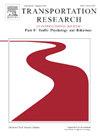研究社会规范方法在减少年轻司机开车时使用手持电话方面的效用
IF 3.5
2区 工程技术
Q1 PSYCHOLOGY, APPLIED
Transportation Research Part F-Traffic Psychology and Behaviour
Pub Date : 2025-04-17
DOI:10.1016/j.trf.2025.04.006
引用次数: 0
摘要
开车时使用手机在年轻司机中很普遍。因此,探索使用新方法来减少这一群体中的这种行为是很重要的。社会规范方法认为,可以通过提供他人参与和认可某种行为的信息来鼓励行为改变。然而,社会规范方法在道路安全方面受到的关注有限。因此,目前的研究旨在检验这种方法是否可以减少年轻司机在驾驶时使用手持电话的自我报告。采用3(时间:基线、干预后、随访)× 3(信息:社会规范[n = 27]、主动对照[n = 27]、非主动对照[n = 29])混合因子设计,纳入83名居住在澳大利亚昆士兰州的年轻司机。在社会规范组和基于恐惧的组(主动控制)中,在一周(仅针对社会规范信息)和一个月的随访(显示中等到较大的效应)中,驾驶时使用手持电话的认可显著减少,对他人(相同年龄和性别)参与该行为的看法也显著减少。此外,在社会规范组中,对他人(同年龄、同性别和同年龄)对这种行为的认可的看法减少了。最后,驾车时使用手持电话的自我报告在整个样本中显著减少,但在各组之间没有差异。本文章由计算机程序翻译,如有差异,请以英文原文为准。
Examining the utility of the social norm approach in reducing young drivers hand-held phone use while driving
Hand-held phone use while driving is a prevalent behaviour in young drivers. Therefore, it is important to explore the use of novel approaches in reducing this behaviour among this cohort. The social norm approach suggests behaviour change can be encouraged by providing information on others’ engagement in, and approval of, a behaviour. Yet, the social norm approach has received limited attention in road safety. Therefore, the current study aimed to examine whether the approach could reduce young drivers’ self-reported engagement in hand-held phone use while driving over time. A 3 (time: baseline, post-intervention, follow-up) × 3 (message: social norm [n = 27], active control [n = 27], non-active control [n = 29]) mixed-factorial design was conducted, involving 83 young drivers residing in Queensland, Australia. In the social norm group and fear-based group (active control), approval of hand-held phone use while driving significantly reduced, as well as perceptions of others’ (of the same age and gender) engagement in the behaviour, at a one-week (for the social norm message only) and one-month follow-up (revealing medium-to-large effect sizes). Further, perceptions of others’ (of the same age and gender and of the same age) approval of the behaviour reduced in the social norm group. Finally, self-reported engagement in hand-held phone use while driving significantly reduced across the sample, yet did not vary between groups.
求助全文
通过发布文献求助,成功后即可免费获取论文全文。
去求助
来源期刊
CiteScore
7.60
自引率
14.60%
发文量
239
审稿时长
71 days
期刊介绍:
Transportation Research Part F: Traffic Psychology and Behaviour focuses on the behavioural and psychological aspects of traffic and transport. The aim of the journal is to enhance theory development, improve the quality of empirical studies and to stimulate the application of research findings in practice. TRF provides a focus and a means of communication for the considerable amount of research activities that are now being carried out in this field. The journal provides a forum for transportation researchers, psychologists, ergonomists, engineers and policy-makers with an interest in traffic and transport psychology.

 求助内容:
求助内容: 应助结果提醒方式:
应助结果提醒方式:


